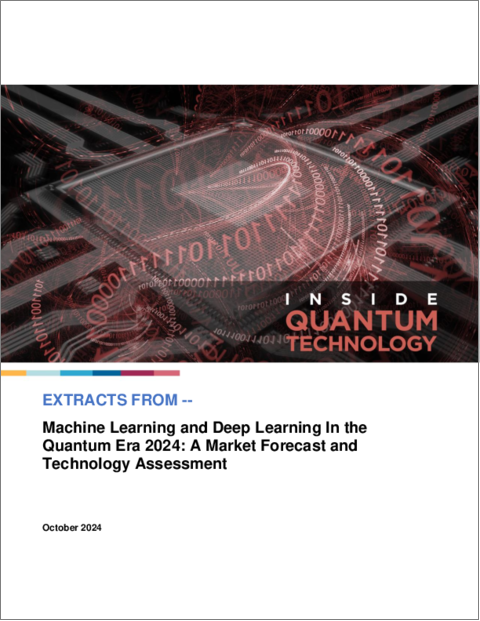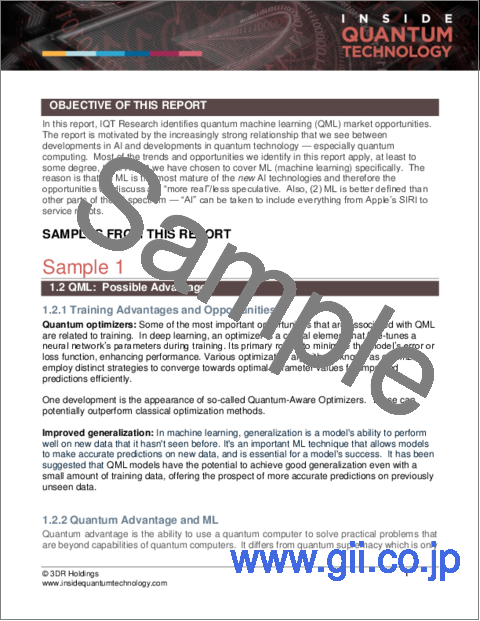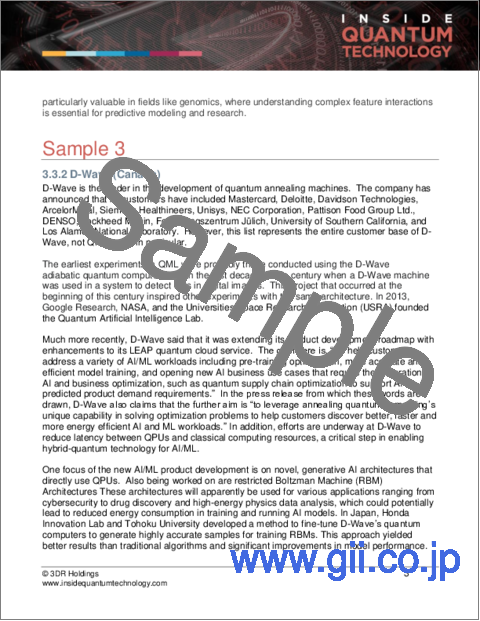|
|
市場調査レポート
商品コード
1536238
量子時代の機械学習と深層学習(2024年):市場予測と技術評価Machine Learning and Deep Learning in the Quantum Era 2024: A Market Forecast and Technology Assessment |
||||||
|
|||||||
| 量子時代の機械学習と深層学習(2024年):市場予測と技術評価 |
|
出版日: 2024年11月20日
発行: Inside Quantum Technology
ページ情報: 英文 70 Pages
納期: 即納可能
|
全表示
- 概要
- 目次
機械学習(ML)は、AI市場において最も成熟した分野のひとつであり、その歴史は1950年代に遡ります。MLは機械に特定のタスクを実行させ、パターンを特定することで正確な結果を提供するよう教えます。量子コンピュータの登場は、量子コンピューティングのパワーをMLにどのように応用できるかという推測につながっています。量子機械学習(QML)は、実行時間の高速化、学習効率の向上、学習能力の向上という点で、古典的なMLを改善できるというコンセンサスが形成されつつあります。
当レポートでは、量子時代の機械学習と深層学習について調査し、QMLのビジネスチャンスと用途を特定し、すでに出現し始めているもの、また将来出現すると思われるものを紹介します。また、QML技術がどのように進化していくかを論じ、この分野で活躍する25の主要企業や研究機関のプロファイルと共に、QML収益の10年予測も掲載しています。また、量子機械学習のコストや未成熟さ、QMLに最適化されたアルゴリズムの必要性、QMLの最適な導入方法に関するより深い理解など、QMLの成長を阻む要因についても分析しています。
目次
エグゼクティブサマリー
第1章 量子機械学習の可能性の概要
- このレポートの目的
- QML:考えられるメリット
- QML:考えられるデメリット
- 本報告書の計画
- 情報源
- 予測調査手法
第2章 QMLアルゴリズムとソフトウェアの可能性
- 機械学習とその出現
- 機械学習の種類
- 量子深層学習と量子ニューラルネットワーク
- 量子バックプロパゲーションの台頭
- QMLのトランスフォーマー
- QDLにおけるパーセプトロン
- MLとデータセットに関するいくつかの注意事項
- 量子アルゴリズム:開発と機会
- 大規模データセットの取り扱い:量子主成分分析
- グローバーアルゴリズムの用途
- 最適化技術の改善
- QML-over-the-CloudとQML-as-a-Service
- QMLにおけるセキュリティとプライバシー
- QMLソフトウェア企業
- Dassault/Abaqus
- GenMat
- Microsoft
- OTI Lumionics
- PennyLane/Xanadu
- ProteinQure
- 1Qbit and Good Chemistry
- QC Ware
- QpiAI
- Quantistry
第3章 QMLハードウェアの考慮事項
- 量子アニーリング
- NISQコンピュータとQML
- NISQを超えたQML
- QMLを使用した量子ハードウェアの製造と最適化
- 機械学習とQRNGに関するメモ
第4章 QMLの応用
- QMLの機会のイントロダクション
- 金融および銀行におけるQMLの応用
- ヘルスケアとライフサイエンス
- 製造業におけるQMLの応用
- その他におけるQMLの応用
第5章 QMLの10年予測
Machine learning (ML) is one of the most mature segments of the AI market - it dates to the 1950s. ML teaches machines to perform specific tasks and provide accurate results by identifying patterns. The advent of quantum computers has led to speculations on how the power of quantum computing can be applied to ML. A consensus is building that Quantum Machine Learning (QML) can improve classical ML in terms of faster run times, increased learning efficiencies and boosted learning capacity.
QML exhibits several emerging trends:
- Using quantum computers to solve traditional ML problems.
- Developing improved ML algorithms better suited to QML.
- Investigating new ways of delivering QML, especially over a cloud.
- Using classical ML to optimize quantum hardware operations, control systems, and user interfaces.
In this report, IQT Research identifies QML opportunities and applications already beginning to appear and those that we believe will emerge in the future. We also discuss how QML technology will evolve and include ten-year forecasts of QML revenues, along with profiles of 25 profiles of leading firms and research institutes active in the field. The report also analyzes the factors retarding the growth of QML such as the cost and immaturity of quantum machine learning, the need for QML-optimized algorithms and a deeper understanding of how QML is best deployed.
Table of Contents
Executive Summary
- E.1. Factors Driving the Quantum Machine Learning Market
- E.2. Opportunities in Algorithms and Software for QML
- E.2.1. Translating ML into QML: The First Phase of QML
- E.2.2. New Algorithms and Products: The Second Phase of QML
- E.3. Thoughts on Deep Learning
- E.4. Advantages of QML
- E.4.1. Improved Optimization and Generalization
- E.4.2. QML and Quantum Advantage
- E.5. The Disadvantages of QML
- E.5.1. High Cost of QCs
- E.5.2. Early Stage of Technology
- E.5.3. The Workforce Problem
- E.6. QML Roadmap and Forecasts
Chapter One: A Summary of Quantum Machine Learning Opportunities
- 1.1. Objective of this Report
- 1.2. QML: Possible Advantages
- 1.2.1. Training Advantages and Opportunities
- 1.2.2. Quantum Advantage and ML
- 1.2.3. Improved Accuracy
- 1.3. QML: Possible Disadvantages
- 1.3.1. Training Challenges
- 1.3.2. Uncertainty Regarding Quantum Advantage
- 1.3.3. Quantum Memory Issues
- 1.3.4. Comparisons of the Prospects and Challenges of QML at the Present Time
- 1.4. Plan of this Report
- 1.5. Information Sources
- 1.6. Forecasting Methodology
Chapter Two: Opportunities in QML Algorithms and Software
- 2.1. Machine Learning and its Emergence
- 2.2. Types of Machine Learning
- 2.3. Quantum Deep Learning and Quantum Neural Networks
- 2.3.1. Quantum Deep Learning (a.k.a. Deep Quantum Learning)
- 2.3.2. Training Quantum Neural Networks
- 2.3.3. Possible Applications for Quantum Neural Networks
- 2.3.4. Types of Neural Networks
- 2.3.5. Quantum Generative Adversarial Networks
- 2.4. The Rise of Quantum Backpropagation
- 2.5. Transformers in QML
- 2.6. Perceptrons in QDL
- 2.7. Some Notes on ML and Datasets
- 2.8. Quantum Algorithms: Development and Opportunities
- 2.8.1. Quantum Encoding
- 2.8.2. Example of other QML Algorithms
- 2.8.3. Hybrid Quantum/Classical ML and the Path to True QML
- 2.9. Handling Larger Data Sets: Quantum Principal Component Analysis
- 2.9.1. Dimensionality Reduction: Quantum Principal Component Analysis
- 2.10. Uses of Grover's Algorithm
- 2.11. Improved Optimization Techniques
- 2.12. QML-over-the-Cloud and QML-as-a-Service
- 2.13. Security and Privacy in QML
- 2.13.1. Growing QML Vulnerabilities During the Training and Inference Phases
- 2.13.2. Security on QML Clouds and QML-as-a-Service
- 2.13.3. Security on QML Architecture
- 2.14. QML Software Companies
- 2.14.1. Dassault/Abaqus (United States)
- 2.14.2. GenMat (United States)
- 2.14.3. Google (United States)
- 2.14.4. Microsoft (United States)
- 2.14.5. OTI Lumionics
- 2.14.6. PennyLane/Xanadu (Canada)
- 2.14.7. ProteinQure (Canada)
- 2.14.8. 1Qbit and Good Chemistry (Canada)
- 2.14.9. QC Ware (United States)
- 2.14.10. QpiAI (India)
- 2.14.11. Quantistry (Germany)
Chapter Three: QML Hardware Considerations
- 3.1. Quantum Annealing
- 3.1.1. A Note on Boltzman Machines
- 3.1.2. D-Wave (Canada)
- 3.2. NISQ Computers and QML
- 3.2.1. Amazon/AWS (United States)
- 3.2.2. Atom Computing
- 3.2.3. Google AI (United States)
- 3.2.4. IBM (United States)
- 3.2.5. IonQ (United States)
- 3.2.6. Nordic Quantum Computing Group (Norway)
- 3.2.7. ORCA Computing (UK)
- 3.2.8. Oxford Quantum Circuits (United Kingdom)
- 3.2.9. Pasqal (France)
- 3.2.10. planqc (Germany)
- 3.2.11. QuEra (United States)
- 3.2.12. Quantinuum (United States)
- 3.2.13. Rigetti (United States)
- 3.2.14. Terra Quantum (Switzerland)
- 3.3. QML beyond NISQ
- 3.4. Fabricating and Optimizing Quantum Hardware Using QML
- 3.4.1. Mind Foundry (United Kingdom)
- 3.4.2. QuantrolOx (UK/Finland)
- 3.5. A Note on Machine Learning and QRNGs
Chapter Four: Applications for QML
- 4.1. Introduction to QML Opportunities
- 4.2. Financial and Banking Applications for QML
- 4.2.1. Adaptive Finance (Canada)
- 4.2.2. Qkrishi (India)
- 4.3. Healthcare and Life Sciences
- 4.3.1. Impact of Sensors as a Source of QML-based Diagnostic Data
- 4.3.2. QML and Personalized Medicine
- 4.3.3. Pharma and QML
- 4.3.4. Kuano (Lithuania)
- 4.3.5. QunaSys (Japan)
- 4.3.6. MentenAI (Canada)
- 4.4. Manufacturing Sector Applications for QML
- 4.5. Other Applications for QML
Chapter Five: Ten-Year Forecasts of QML
- 5.1. Background to Forecasts
- 5.1.1. Reasons to Doubt QML
- 5.2. Forecast of QML as Technology
- 5.3. Forecast of QML by Application
- About the Analyst
List of Exhibits
- Exhibit E-1: Ten-year Revenues from Quantum Machine Learning and Quantum Deep Learning ($ Millions)
- Exhibit 1-1: Variations on a QML Theme: The Six Segments of the Quantum Machine Language Market
- Exhibit 1-2: Pros and Cons of QML
- Exhibit 2-1: The Relationship Between AI, Machine Learning, Deep Learning and Quantum Computing
- Exhibit 2-2: Types of ML Learning
- Exhibit 2-3: Selected Neural Network Type/Algorithms
- Exhibit 2-4: ML Transformer Applications
- Exhibit 2-5: Characteristics of ML Data by Source
- Exhibit 2-6: Selected QML Encoding Schemes
- Exhibit 2-7: Other QML Algorithms of Importance
- Exhibit 4-1: Selected Applications for QML in Banking and Financial Services
- Exhibit 4-2: Other Potential Applications of QML
- Exhibit 5-1: Ten-year Revenues from Quantum Machine Learning and Quantum Deep Learning ($ Millions)
- Exhibit 5-2: Ten-year Revenues - QML/ QDL by Application ($ Millions)






